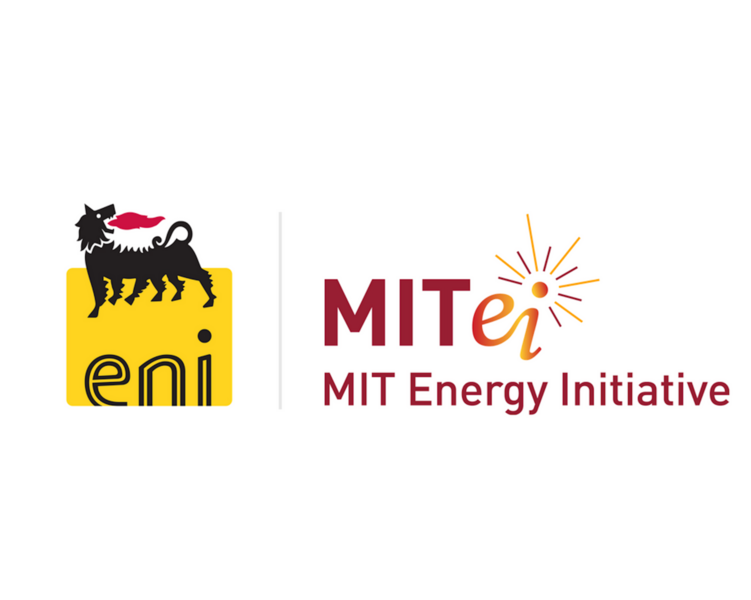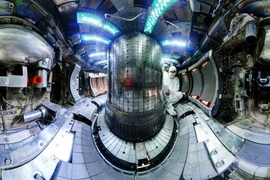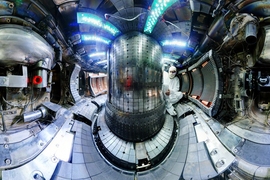A new chapter is beginning for fusion energy research at MIT.
This week the Italian energy company Eni, a founding member of the MIT Energy Initiative (MITEI), announced it has reached an agreement with MIT to fund fusion research projects run out of the MIT Plasma Science and Fusion Center (PSFC)’s newly created Laboratory for Innovation in Fusion Technologies (LIFT). The expected investment in these research projects will amount to about $2 million over the following years.
This is part of a broader engagement with fusion research and the Institute as a whole: Eni also announced a commitment of $50 million to a new private company with roots at MIT, Commonwealth Fusion Systems (CFS), which aims to make affordable, scalable fusion power a reality.
“This support of LIFT is a continuation of Eni’s commitment to meeting growing global energy demand while tackling the challenge of climate change through its research portfolio at MIT,” says Robert C. Armstrong, MITEI’s director and the Chevron Professor of Chemical Engineering at MIT. “Fusion is unique in that it is a zero-carbon, dispatchable, baseload technology, with a limitless supply of fuel, no risk of runaway reaction, and no generation of long-term waste. It also produces thermal energy, so it can be used for heat as well as power.”
Still, there is much more to do along the way to perfecting the design and economics of compact fusion power plants. Eni will fund research projects at LIFT that are a continuation of this research and focus on fusion-specific solutions. “We are thrilled at PSFC to have these projects funded by Eni, who has made a clear commitment to developing fusion energy,” says Dennis Whyte, the director of PSFC and the Hitachi America Professor of Engineering at MIT. “LIFT will focus on cutting-edge technology advancements for fusion, and will significantly engage our MIT students who are so adept at innovation.”
Tackling fusion’s challenges
The inside of a fusion device is an extreme environment. The creation of fusion energy requires the smashing together of light elements, such as hydrogen, to form heavier elements such as helium, a process that releases immense amounts of energy. The temperature at which this process takes place is too hot for solid materials, necessitating the use of magnets to hold the hot plasma in place.
One of the projects PSFC and Eni intend to carry out will study the effects of high magnetic fields on molten salt fluid dynamics. One of the key elements of the fusion pilot plant currently being studied at LIFT is the liquid immersion blanket, essentially a flowing pool of molten salt that completely surrounds the fusion energy core. The purpose of this blanket is threefold: to convert the kinetic energy of fusion neutrons to heat for eventual electricity production; to produce tritium — a main component of the fusion fuel; and to prevent the neutrons from reaching other parts of the machine and causing material damage.
It’s critical for researchers to be able to predict how the molten salt in such an immersion blanket would move when subjected to high magnetic fields such as those found within a fusion plant. As such, the researchers and their respective teams plan to study the effects of these magnetohydrodynamic forces on the salt’s fluid dynamics.
A history of innovation
During the 23 years MIT’s Alcator C-Mod tokamak fusion experiment was in operation, it repeatedly advanced records for plasma pressure in a magnetic confinement device. Its compact, high-magnetic-field fusion design confined superheated plasma in a small donut-shaped chamber.
“The key to this success was the innovations pursued more than 20 years ago at PSFC in developing copper magnets that could access fields well in excess of other fusion experiments. The coupling between innovative technology development and advancing fusion science is in the DNA of the Plasma Science and Fusion Center,” says PSFC Deputy Director Martin Greenwald.
In its final run in 2016, Alcator C-Mod set a new world record for plasma pressure, the key ingredient to producing net energy from fusion. Since then, PSFC researchers have used data from these decades of C-Mod experiments to continue to advance fusion research. Just last year, they used C-Mod data to create a new method of heating fusion plasmas in tokamaks which could result in the heating of ions to energies an order of magnitude greater than previously reached.
A commitment to low-carbon energy
MITEI’s mission is to advance low-carbon and no-carbon emissions solutions to efficiently meet growing global energy needs. Critical to this mission are collaborations between academia, industry, and government — connections MITEI helps to develop in its role as MIT’s hub for multidisciplinary energy research, education, and outreach.
Eni is an inaugural, founding member of the MIT Energy Initiative, and it was through their engagement with MITEI that they became aware of the fusion technology commercialization being pursued by CFS and its immense potential for revolutionizing the energy system. It was through these discussions, as well, that Eni investors learned of the high-potential fusion research projects taking place through LIFT at MIT, spurring them to support the future of fusion at the Institute itself.
Eni CEO Claudio Descalzi said, “Today is a very important day for us. Thanks to this agreement, Eni takes a significant step forward toward the development of alternative energy sources with an ever lower environmental impact. Fusion is the true energy source of the future, as it is completely sustainable, does not release emissions or waste, and is potentially inexhaustible. It is a goal that we are determined to reach quickly.” He added, “We are pleased and excited to pursue such a challenging goal with a collaborator like MIT, with unparalleled experience in the field and a long-standing and fruitful alliance with Eni.”
These fusion projects are the latest in a line of MIT-Eni collaborations on low- and no-carbon energy projects. One of the earliest of these was the Eni-MIT Solar Frontiers Center, established in 2010 at MIT. Through its mission to develop competitive solar technologies, the center’s research has yielded the thinnest, lightest solar cells ever produced, effectively able to turn any surface, from fabric to paper, into a functioning solar cell. The researchers at the center have also developed new, luminescent materials that could allow windows to efficiently collect solar power.
Other fruits of MIT-Eni collaborations include research into carbon capture systems to be installed in cars, wearable technologies to improve workplace safety, energy storage, and the conversion of carbon dioxide into fuel.










